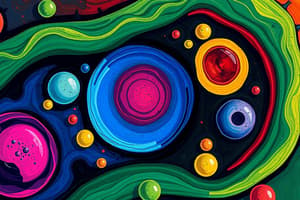Podcast
Questions and Answers
What is the primary function of the mitochondria in a cell?
What is the primary function of the mitochondria in a cell?
- Cell division
- Energy generation (correct)
- Waste recycling
- Protein synthesis
Which component of the cell is responsible for communication between cells and their environment?
Which component of the cell is responsible for communication between cells and their environment?
- Plasma membrane (correct)
- Endoplasmic reticulum
- Cytoplasm
- Nucleus
What is the process by which plants convert light energy into chemical energy called?
What is the process by which plants convert light energy into chemical energy called?
- Cell division
- Cell signaling
- Photosynthesis (correct)
- Metabolism
Which of the following cell types lacks a true nucleus?
Which of the following cell types lacks a true nucleus?
Which organelle is primarily involved in protein modification and transport?
Which organelle is primarily involved in protein modification and transport?
What type of cell division results in four daughter cells with half the number of chromosomes as the parent cell?
What type of cell division results in four daughter cells with half the number of chromosomes as the parent cell?
Flashcards are hidden until you start studying
Study Notes
Structure and Components
- Plasma membrane: semi-permeable membrane that separates the cell from its environment
- Cytoplasm: jelly-like substance inside the plasma membrane where metabolic processes occur
- Cytosol: liquid component of cytoplasm where many metabolic reactions take place
- Organelles: specialized structures within the cell that perform specific functions
- Nucleus: contains DNA and is responsible for cell growth and reproduction
- Mitochondria: generates energy for the cell through cellular respiration
- Endoplasmic reticulum (ER): involved in protein synthesis and transport
- Ribosomes: site of protein synthesis
- Lysosomes: contains digestive enzymes that break down and recycle cellular waste
- Golgi apparatus: involved in protein modification and transport
Cellular Functions
- Metabolism: process of converting energy and nutrients into cellular components
- Photosynthesis: process by which plants convert light energy into chemical energy
- Cell signaling: process of communication between cells and their environment
- Cell division: process by which cells reproduce themselves
- Mitosis: process of cell division that results in two daughter cells with same number of chromosomes as parent cell
- Meiosis: process of cell division that results in four daughter cells with half the number of chromosomes as parent cell
Cell Types
- Prokaryotic cells: lack a true nucleus and are typically small and simple in structure (e.g. bacteria)
- Eukaryotic cells: have a true nucleus and are typically larger and more complex in structure (e.g. plants, animals)
- Stem cells: undifferentiated cells that have the ability to differentiate into specialized cells
Cellular Processes
- Active transport: process by which cells use energy to move molecules against their concentration gradient
- Passive transport: process by which cells move molecules down their concentration gradient
- Cell growth: process by which cells increase in size and number
- Cell death: process by which cells die and are removed from the body (e.g. apoptosis)
Structure and Components
- Plasma membrane acts as a semi-permeable barrier, controlling the entry and exit of substances, and maintaining homeostasis.
- Cytoplasm is a jelly-like medium supporting organelles and facilitating metabolic reactions.
- Cytosol is the liquid portion of cytoplasm where many biochemical processes take place, including enzyme activity and nutrient transport.
- Organelles are specialized cellular structures, each fulfilling distinct roles essential for cell function.
- Nucleus houses genetic material (DNA) and orchestrates cell growth, division, and reproduction.
- Mitochondria are the powerhouses of the cell, producing ATP through cellular respiration, critical for energy supply.
- Endoplasmic reticulum (ER) comes in two forms—rough (with ribosomes) for protein synthesis and smooth (without ribosomes) for lipid synthesis and detoxification.
- Ribosomes are the cellular machinery for translating mRNA into proteins, vital for all cellular functions.
- Lysosomes contain hydrolytic enzymes for degrading waste materials and cellular debris, playing a key role in recycling and cellular cleanup.
- Golgi apparatus modifies, sorts, and packages proteins and lipids for distribution within or outside the cell.
Cellular Functions
- Metabolism encompasses all chemical reactions converting nutrients into energy and building blocks for the cell.
- Photosynthesis converts light energy into glucose in plants, releasing oxygen as a byproduct, essential for life on Earth.
- Cell signaling involves mechanisms through which cells communicate with one another and respond to environmental stimuli, crucial for coordinating functions.
- Cell division is the method by which cells reproduce, ensuring genetic material is passed on to daughter cells.
- Mitosis produces two genetically identical daughter cells, maintaining chromosome number, essential for growth and repair.
- Meiosis results in four genetically diverse daughter cells with half the chromosomes, foundational for sexual reproduction and genetic diversity.
Cell Types
- Prokaryotic cells lack a membrane-bound nucleus, are typically unicellular, and include organisms like bacteria; their simplicity allows for rapid reproduction.
- Eukaryotic cells possess a defined nucleus and complex organelles, are generally larger, and comprise multicellular organisms such as plants and animals.
- Stem cells are unique as undifferentiated cells that can develop into various specialized cell types, important for growth, development, and repair.
Cellular Processes
- Active transport requires energy (ATP) to move molecules against their concentration gradient, essential for nutrient uptake and waste removal.
- Passive transport allows molecules to diffuse across membranes without energy expenditure, following concentration gradients, vital for maintaining equilibrium.
- Cell growth involves both an increase in cellular size and replication, supporting organismal development and tissue maintenance.
- Cell death, or apoptosis, is a regulated process that eliminates excess or damaged cells, ensuring tissue health and homeostasis.
Studying That Suits You
Use AI to generate personalized quizzes and flashcards to suit your learning preferences.




